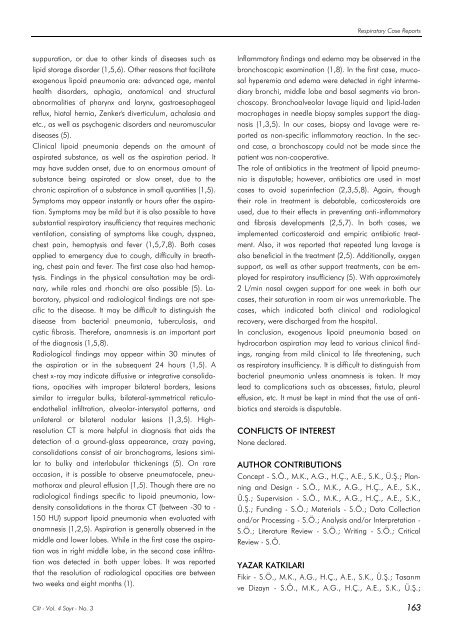Respircase Cilt: 4 - Sayı: 3 Yıl: 2015
You also want an ePaper? Increase the reach of your titles
YUMPU automatically turns print PDFs into web optimized ePapers that Google loves.
Respiratory Case Reports<br />
suppuration, or due to other kinds of diseases such as<br />
lipid storage disorder (1,5,6). Other reasons that facilitate<br />
exogenous lipoid pneumonia are: advanced age, mental<br />
health disorders, aphagia, anatomical and structural<br />
abnormalities of pharynx and larynx, gastroesophageal<br />
reflux, hiatal hernia, Zenker's diverticulum, achalasia and<br />
etc., as well as psychogenic disorders and neuromuscular<br />
diseases (5).<br />
Clinical lipoid pneumonia depends on the amount of<br />
aspirated substance, as well as the aspiration period. It<br />
may have sudden onset, due to an enormous amount of<br />
substance being aspirated or slow onset, due to the<br />
chronic aspiration of a substance in small quantities (1,5).<br />
Symptoms may appear instantly or hours after the aspiration.<br />
Symptoms may be mild but it is also possible to have<br />
substantial respiratory insufficiency that requires mechanic<br />
ventilation, consisting of symptoms like cough, dyspnea,<br />
chest pain, hemoptysis and fever (1,5,7,8). Both cases<br />
applied to emergency due to cough, difficulty in breathing,<br />
chest pain and fever. The first case also had hemoptysis.<br />
Findings in the physical consultation may be ordinary,<br />
while rales and rhonchi are also possible (5). Laboratory,<br />
physical and radiological findings are not specific<br />
to the disease. It may be difficult to distinguish the<br />
disease from bacterial pneumonia, tuberculosis, and<br />
cystic fibrosis. Therefore, anamnesis is an important part<br />
of the diagnosis (1,5,8).<br />
Radiological findings may appear within 30 minutes of<br />
the aspiration or in the subsequent 24 hours (1,5). A<br />
chest x-ray may indicate diffusive or integrative consolidations,<br />
opacities with improper bilateral borders, lesions<br />
similar to irregular bulks, bilateral-symmetrical reticuloendothelial<br />
infiltration, alveolar-intersystol patterns, and<br />
unilateral or bilateral nodular lesions (1,3,5). Highresolution<br />
CT is more helpful in diagnosis that aids the<br />
detection of a ground-glass appearance, crazy paving,<br />
consolidations consist of air bronchograms, lesions similar<br />
to bulky and interlobular thickenings (5). On rare<br />
occasion, it is possible to observe pneumatocele, pneumothorax<br />
and pleural effusion (1,5). Though there are no<br />
radiological findings specific to lipoid pneumonia, lowdensity<br />
consolidations in the thorax CT (between -30 to -<br />
150 HU) support lipoid pneumonia when evaluated with<br />
anamnesis (1,2,5). Aspiration is generally observed in the<br />
middle and lower lobes. While in the first case the aspiration<br />
was in right middle lobe, in the second case infiltration<br />
was detected in both upper lobes. It was reported<br />
that the resolution of radiological opacities are between<br />
two weeks and eight months (1).<br />
Inflammatory findings and edema may be observed in the<br />
bronchoscopic examination (1,8). In the first case, mucosal<br />
hyperemia and edema were detected in right intermediary<br />
bronchi, middle lobe and basal segments via bronchoscopy.<br />
Bronchoalveolar lavage liquid and lipid-laden<br />
macrophages in needle biopsy samples support the diagnosis<br />
(1,3,5). In our cases, biopsy and lavage were reported<br />
as non-specific inflammatory reaction. In the second<br />
case, a bronchoscopy could not be made since the<br />
patient was non-cooperative.<br />
The role of antibiotics in the treatment of lipoid pneumonia<br />
is disputable; however, antibiotics are used in most<br />
cases to avoid superinfection (2,3,5,8). Again, though<br />
their role in treatment is debatable, corticosteroids are<br />
used, due to their effects in preventing anti-inflammatory<br />
and fibrosis developments (2,5,7). In both cases, we<br />
implemented corticosteroid and empiric antibiotic treatment.<br />
Also, it was reported that repeated lung lavage is<br />
also beneficial in the treatment (2,5). Additionally, oxygen<br />
support, as well as other support treatments, can be employed<br />
for respiratory insufficiency (5). With approximately<br />
2 L/min nasal oxygen support for one week in both our<br />
cases, their saturation in room air was unremarkable. The<br />
cases, which indicated both clinical and radiological<br />
recovery, were discharged from the hospital.<br />
In conclusion, exogenous lipoid pneumonia based on<br />
hydrocarbon aspiration may lead to various clinical findings,<br />
ranging from mild clinical to life threatening, such<br />
as respiratory insufficiency. It is difficult to distinguish from<br />
bacterial pneumonia unless anamnesis is taken. It may<br />
lead to complications such as abscesses, fistula, pleural<br />
effusion, etc. It must be kept in mind that the use of antibiotics<br />
and steroids is disputable.<br />
CONFLICTS OF INTEREST<br />
None declared.<br />
AUTHOR CONTRIBUTIONS<br />
Concept - S.Ö., M.K., A.G., H.Ç., A.E., S.K., Ü.Ş.; Planning<br />
and Design - S.Ö., M.K., A.G., H.Ç., A.E., S.K.,<br />
Ü.Ş.; Supervision - S.Ö., M.K., A.G., H.Ç., A.E., S.K.,<br />
Ü.Ş.; Funding - S.Ö.; Materials - S.Ö.; Data Collection<br />
and/or Processing - S.Ö.; Analysis and/or Interpretation -<br />
S.Ö.; Literature Review - S.Ö.; Writing - S.Ö.; Critical<br />
Review - S.Ö.<br />
YAZAR KATKILARI<br />
Fikir - S.Ö., M.K., A.G., H.Ç., A.E., S.K., Ü.Ş.; Tasarım<br />
ve Dizayn - S.Ö., M.K., A.G., H.Ç., A.E., S.K., Ü.Ş.;<br />
<strong>Cilt</strong> - Vol. 4 <strong>Sayı</strong> - No. 3 163

















